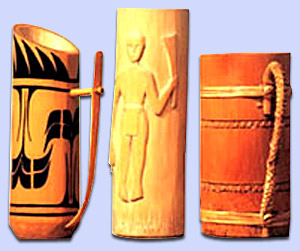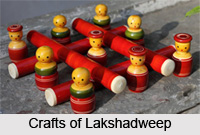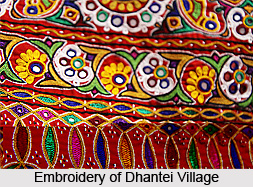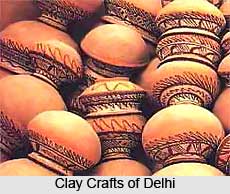 Clay crafts of Delhi are predominantly based on Blue pottery which was introduced to India from the land of Persia via Isfahan, Samarkhand, Kabul and Peshawar by the Islamic invaders. The Muslim tradition was introduced to India as different dynasties settled in different regions of India. Along with them, the artisans came and their technique of making blue pottery was introduced to the Indian artisans. The clay they used in creating the clay crafts of Delhi was predominantly blue in colour.
Clay crafts of Delhi are predominantly based on Blue pottery which was introduced to India from the land of Persia via Isfahan, Samarkhand, Kabul and Peshawar by the Islamic invaders. The Muslim tradition was introduced to India as different dynasties settled in different regions of India. Along with them, the artisans came and their technique of making blue pottery was introduced to the Indian artisans. The clay they used in creating the clay crafts of Delhi was predominantly blue in colour.
With the beginning of the British period in the early 17th century, the clay craft of Delhi was rechristened as `Delhi Blue.` The artisans of Blue pottery used to reside basically at Khurja, a village 100 kilometres away from Delhi. By this time, artisans of Khurja used to produce cheap, easily marketable items. The technique of Blue pottery which is the use of blue glaze on pottery made from Multani mitti (Fuller`s earth). This is basically an imported technique developed by enterprising Mongol artisans. With their own intellect, the Indian craftsmen amalgamated Chinese glazing technology with Persian decorative arts to render the craft articles an additional sheen and style. At the basic period, the Blue pottery was predominantly used in creating tiles to decorate mosques, tombs and palaces.
The later history of the clay crafts of Delhi depicts that the Mughals began using them in India extensively. This craftsmanship became the well known artistry in India and as a result Delhi was traced as the most important centre of this craft. In this particular craft, the Persian blue dye bestows the attractive colour. The Delhi Blue pottery has attained its identification due to the fact that the created articles were characterised by a rich glazed blue surface. The articles are beautifully painted with Mughal motifs and are accented by other colours on a clear, white base.
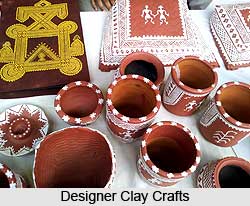 In Delhi the clay vessels are an important part of the domestic life. In Delhi most of the potters have migrated from the neighbouring states of Rajasthan and Haryana, the rest are from the villages around Delhi. The various types of clay ware that are usually made in Delhi are water pots, small cups, dishes, money boxes and flowerpots. The clay crafts of Delhi also include various utilitarian and decorative items of splendid geometric design, bowls, plates, and vases, tea sets, cups and saucers, plates and glasses, jugs, ashtrays etc.
In Delhi the clay vessels are an important part of the domestic life. In Delhi most of the potters have migrated from the neighbouring states of Rajasthan and Haryana, the rest are from the villages around Delhi. The various types of clay ware that are usually made in Delhi are water pots, small cups, dishes, money boxes and flowerpots. The clay crafts of Delhi also include various utilitarian and decorative items of splendid geometric design, bowls, plates, and vases, tea sets, cups and saucers, plates and glasses, jugs, ashtrays etc.
The new trend in Delhi is that the potters of the region are catering to the growing needs of the consumer middle-class and in the process are gradually moving away from the classic traditional forms. The water pots which are prepared in Delhi have a pure forms and generous, full round bodies.
The process of pottery involves wedging the clay with the feet of the potter, systematically stamping in lines up and down the clay until the potter is satisfied that the clay is thoroughly mixed. A popular press-moulding technique is used to make water pots with raised linear decoration. After the patterns have been carved out with a sharp metal tool, they are fired. One section of the mould contains a round hole at the bottom which will allow the neck and rim to be formed later. Hand has a lot of use in the making of pots, Hands are used to flatten the clay and for pressing it.
In Delhi for a number of rituals pottery finds a lot of use. For instance when a baby has been born, the pot is needed for a protective ceremony. Holes are pierced into the shoulder of the pot and a fire of cow dung ignited inside and covered with a lid. The flame will be kept alive for seven days to keep evil away from the baby, after which the pot will be thrown far away from the house.
It is believed in the region that pottery is the barometer of good and evil in the Indian household. Cleansed and made pure by fire, vessels readily absorb negative energy (anger, sorrow, pain or fear). When they are broken outside the home - especially when immersed in water - that inauspiciousness is dispersed and the family absolved.
To promote the great artistry of Blue pottery, the Delhi Blue Pottery Trust was founded in 1991 in South Delhi. This organisation runs a pottery school in the basement of the Delhi Blue Apartments.



